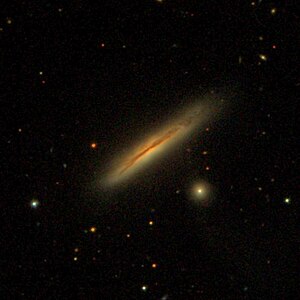NGC 52
| Galaxie NGC 52 | |
|---|---|
 | |
| SDSS-Aufnahme | |
| AladinLite | |
| Sternbild | Pegasus |
| Position Äquinoktium: J2000.0, Epoche: J2000.0 | |
| Rektaszension | 00h 14m 40,11s [1] |
| Deklination | +18° 34′ 55,3″ [1] |
| Erscheinungsbild | |
| Morphologischer Typ | Sc[1] |
| Helligkeit (visuell) | 13,7 mag[2] |
| Helligkeit (B-Band) | 14,4 mag[2] |
| Winkelausdehnung | 2,2′ × 0,4′[2] |
| Positionswinkel | 126°[2] |
| Flächenhelligkeit | 13,4 mag/arcmin²[2] |
| Physikalische Daten | |
| Rotverschiebung | 0.018012 ± 0.000009[1] |
| Radialgeschwindigkeit | (5400 ± 3) km/s[1] |
| Hubbledistanz H0 = 73 km/(s • Mpc) | (248 ± 17) · 106 Lj (76 ± 5,3) Mpc [1] |
| Durchmesser | 150.000 Lj[3] |
| Geschichte | |
| Entdeckung | Wilhelm Herschel |
| Entdeckungsdatum | 18. September 1784 |
| Katalogbezeichnungen | |
| NGC 52 • UGC 140 • PGC 978 • CGCG 456-042 • MCG +03-01-030 • IRAS 00120+1818 • 2MASX J00144010+1834551 • GC 25 • H III 183 • h 11 • LDCE 0011 NED002 / WISEA J001440.10+183455.9 | |
NGC 52 ist eine Spiralgalaxie im Sternbild Pegasus. Diese Edge-On-Galaxie ist etwa 248 Millionen Lichtjahre von der Milchstraße entfernt und hat einen Durchmesser von schätzungsweise 150.000 Lichtjahren. Sie hat einen elliptischen Begleiter namens PGC 1563523.
NGC 52 wurde am 18. September 1784 von dem deutsch-britischen Astronomen Wilhelm Herschel entdeckt.[4]
Einzelnachweise
Auf dieser Seite verwendete Medien
Autor/Urheber: Sloan Digital Sky Survey, Lizenz: CC BY 4.0

Angle of view: 4' × 4' (0.3" per pixel), north is up.
Details on the image processing pipeline: https://www.sdss.org/dr14/imaging/jpg-images-on-skyserver/